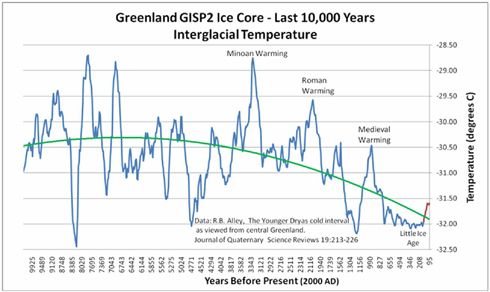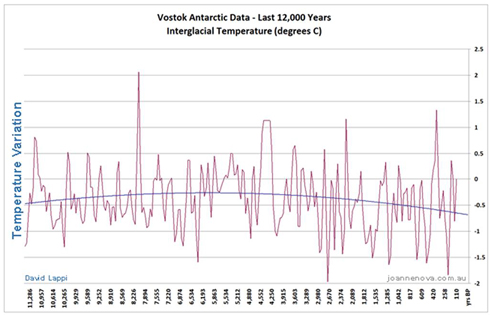Global Cooling, Not Warming, Is the Problem
An excellent summary and discussion of Holocene temperature trends has been posted at JoNova Blog. JoNova is the creation of Joanne Nova, an Australian science writer, former TV host, and the author of The Skeptics Handbook [here].
Her recent post, The Big Picture: 65 Million Years of Temperature Swings [here], was written primarily by David Lappi, Alaska geologist and President of Lapp Resources, Inc.
Of special interest are two graphs derived from ice core proxies, one of Greenland temperatures over the last 10,000 years and one of Antarctica over the last 12,000 years. They clearly demonstrate that polar temperatures have been declining since the Hypsithermal of 6,000 to 9,000 years ago.
The next graph of temperature from the ice core for the last 10,000 years (the current interglacial period) shows that Greenland is now colder than for most of that period (vertical scale in degrees C below zero). We can see the Medieval Warm Period 800 to 1,000 years ago was not particularly warm, and the Little Ice Age 150 to 650 years ago was one of the longest sustained cold periods during this interglacial. We are now recovering from this abnormal cold period, and the recovery started long before anthropogenic greenhouse gases were produced in any quantity. … Our current warming is well within natural variation, and in view of the general decline in temperatures during the last half of this interglacial, is probably beneficial for mankind and most plants and animals. The graph clearly shows the Minoan Warming (about 3200 years ago), the Roman Warming (about 2000 years ago), and the Medieval Warm Period (about 900 years ago). Great advances in government, art, architecture, and science were made during these warmer times.
Graph by David Lappi based on GISP2 Temperature Reconstruction and Accumulation Data [here], NOAA icecore-2475, reported in Alley, R.B. 2000. The Younger Dryas cold interval as viewed from central Greenland. Quaternary Science Reviews 19:213-226 [here]. Click for larger image.
Long-term, temperatures are now declining (for the last 3,000 years), and we appear to be headed for the next 90,000 year ice age, right on schedule at the end of our current 10,000 year warm period. We have repeated this cycle 46 times in succession over the last 2.6 million years. And in case you are wondering, the previous Antarctic ice cores tell a broadly similar story. The following graph of ice core data from Vostok (vertical scale in degrees C variation from present) shows that Antarctica is also experiencing a long-term (4,000 year) cooling trend mirroring the Greenland GISP2 cooling trend. Though the individual temperature spikes and dips are different than in Greenland, the long-term temperature trend on the planet appears to be down, not up. And since it is so late in our current interglacial period, we could be concerned about global cooling.
Graph by David Lappi and Joanne Nova based on temperature reconstructions from the coldest spot on the planet, Russia’s Vostok station in Antarctica. Click for larger image.
Our current warming trend is relatively minor compared to the temperature record of the Holocene. It is likely to be short-lived as well. The long-term future for Mother Earth is another 100,000 year glaciation, the return of continental ice sheets, and the elimination of plants and animals from roughly half of North America and Europe.
Rather than raging paranoia about a minor temperature uptick, we ought to be concerned about long-term temperature declines. If burning fossil fuels can warm the planet, then good. Fossil fuel use also enriches humanity and enhances our survival and comfort.
Warmer Is Better — Fight the Ice
See the List of Historical Plagues in Wikipedia [here]. The most infamous was the bubonic plague, aka the Black Death, that swept through Europe from 1348 to 1353, killing more than 25 million people (some estimate 75 million worldwide), a third of the European population. That was 660 years B.P. (before present) and coincident with the beginning of the Little Ice Age. The New World plagues also occurred in the Little Ice Ages, but were caused by the introduction of Old World diseases ~1520 AD and not climate change, per se.
by Al B.
Note:
Mrs. Nova is married to Dr. David Evans. They both were former AGW supporters but changed positions in light of lack of supporting evidence. See:
Confessions from former greenhouse scientist David Evans [here]
David Evans used to be a consultant to the Australian Greenhouse Office. He spent six years with the Australian government building models about the influence of carbon emissions on our atmosphere. This was the same Australian who wrote the carbon accounting model that measures Australia’s compliance with the Kyoto Protocol.
Forestry is a central component in those models.
by scott
But….the climategate people already got the $7 billion to study global warming….do you really expect them to give that money back? lol
by kenny
Huh? Something is a bit off here.
Mike, notice how warm it’s been in Lebanon? No surprise, then, that January 2010 was the FOURTH WARMEST JANUARY ON RECORD!
http://www.ncdc.noaa.gov/sotc/?report=global
Global cooling? I don’t think so.
Ah Kenny old chum. Don’t let them take your independent brain from you. You can think for yourself, and inquire for yourself, and explore for yourself. Don’t let the warming hoaxers steal that from you.
Yes. Today was a nice day in Lebanon, and Woodburn, but record snows are falling in the East again. We are, after all, in the tail end of an El Nino, with a cold eastern Pacific and high pressure over the Arctic. All these weather events are expected in such conditions.
The NCDC station record has been manipulated. This is one of the coldest winters across most of North America on record, if the record was honest, if NCDC used the actual station data instead of an altered, homogenized, tainted one.
Global warming is supposed to heat up the polar regions. But look at the Greenland ice core record above. Consider that record, and where we stand today compared to the last 10,000 years.
Don’t fall for the propaganda spun by international bankers and powerful greedheads. Don’t be pawned. You’re smarter than that.
The hoaxers are running scared. Their house of cards is falling in on them. Don’t get caught in the rubble. Seek the truth, as I have done. The truth will set you free, and nothing is sweeter than freedom.



You look at the millennial temperatures, and the history of the world in political and economic terms, and you wonder if someday a historian and a climate guy will get together and write a book about how warming affects global economic and political expansion or contraction. The rise and fall of pandemics and their spread. Both on the heating and the cooling side of the mean. Is a gradually heating world conducive to political expansion by warfare due to population increases created by better food and health situations? Or does cooling make for a more aggressive human population? How do grains and legumes move about like Bonnicksen’s forests with different weather regimes. I have read in ag books about how each distinctive area of the world with agriculture has evolved with a unique pairing of a grain and a legume as central to their diet. Asian rice and soy….maize and beans in the Americas…lentils and barley in the steppes…that kind of deal….more questions than answers, I guess.